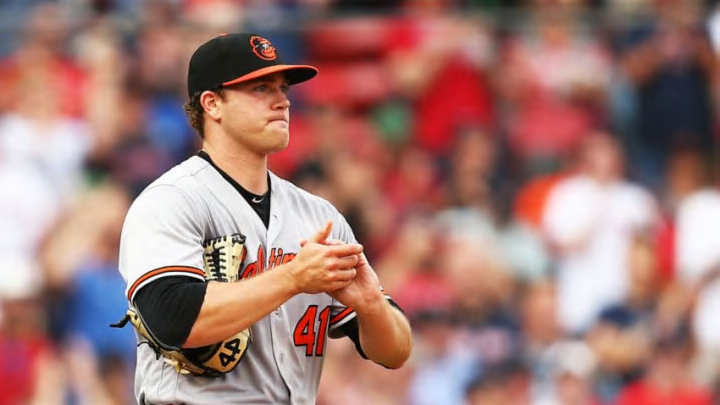Baltimore Orioles: David Hess Has Been Surprisingly Good
By Ben Palmer

Baltimore Orioles pitcher David Hess has had his struggles, but he’s shown some flashes of brilliance during his time in the majors as well.
Outside of Dylan Bundy and some flashes from Kevin Gausman, pitching for the Baltimore Orioles this year (like much of the season) has been difficult to watch.
However, the addition of David Hess to the Baltimore Orioles’ starting rotation has been interesting—on the year so far he’s got a 3.47 ERA, 1.20 WHIP, and a 4.63 K/9. The WHIP and strikeout numbers certainly leave more to be desired, but when you dig into the numbers, there’s a really interesting pitcher here.
First off, his 3.47 ERA comes in spite of giving up a fair number of home runs, with a 13.2% HR/FB rate. He’s also got a 3.37 bbFIP and a 3.87 scFIP (these are xStats numbers, for definitions, I highly recommend reading this article), suggesting that some of that ERA (though not all of it) is fairly legit.
I could also see Hess’ strikeout numbers getting better as he pitches more in the major leagues, because he’s got two very good strikeout pitches in his repertoire.
First and foremost, there’s his slider, which he throws about 27% of the time:
The numbers on the pitch show that it’s a definite money pitch for Hess. So far this year, Hess’ slider has generated a 45.3% chase rate and a 17% whiff rate while Hess has been throwing it in the zone 43.6% of the time.
Those are all excellent numbers for just about any pitch in baseball. As a rule of thumb, if a pitch has a chase rate over 40%, a zone rate over 40%, and a whiff rate over 15%, that’s a quality strikeout pitch. Hess’ slider has all of that.
Opposing hitters struggle against it too, slashing .100/.129/.100 against the pitch with a .000 ISO (yes you read that right) and a .107 wOBA. That pitch is excellent.
Second, he’s got his changeup:
He throws that pitch about 8% of the time, and while it hasn’t seen as much success as his slider, it’s still been a very effective pitch, generating a 57.1% chase rate and a 14.3% whiff rate with Hess throwing it in the zone 50% of the time.
More from Baltimore Orioles
- What other Baltimore Orioles Offseason Storylines will you be interested in seeing?
- Baltimore Orioles to Face Numerous Playoff Contenders Down the Stretch
- Baltimore Orioles Showing Encouraging Signs During Recent Wins
- The Baltimore Orioles and the Expanded September Roster
- Orioles Josh Rogers Expectations in his Major League Debut
Hess has been prone to making some mistakes with it though, as opposing hitters have a .333 ISO and a .423 wOBA against the pitch—though considering he’s only thrown the pitch 28 times so far this year, that’s a pretty small sample size.
So why aren’t Hess’ strikeout numbers better? Well, he’s not relying on his quality breaking pitches as much as he should. He throws his fastball about 61% of the time, and considering the pitch is pretty mediocre, that limits his upside.
So far on the year, opposing hitters are slashing .298/.353/.638 with a .340 ISO and a .416 wOBA against his two-seam fastball, which comes in at a pretty mediocre 93 MPH with average movement.
Hess has a lot of potential, you just need to look at his slider and changeup to see that he’s got two quality breaking balls in his repertoire, but that fastball needs work. It’s possible to be a successful starting pitcher in the major leagues with a garbage fastball and high-quality breaking pitches (just look at Carlos Carrasco), but those breaking pitches need to be excellent and you as a pitcher need to rely on them more.
Next: 2018 Orioles Mock Draft Roundup
Hess isn’t doing that, but it’s still early and he’s still young. Given the potential of his breaking pitches, I’m optimistic that he could turn into a solid starter for the Baltimore Orioles.